7 Best Commercial Weed Eaters of 2024 – Reviews & Buyer’s Guide
-
- Last updated:


A commercial weed eater is a heavily used tool that needs to withstand extreme abuse, and with so many consumer brands available, it can be difficult to sort through the pile to select a decent trimmer that won’t let you down on the job.
We’ve chosen seven different commercial weed eaters to review for you so you can see the differences between them. We’ll tell you about our experience using them and tell you about the pros and cons. We’ve also included a buyer’s guide where we take a close look at the internal components to help you know what to look for while you shop.
Join us while we look at the motor size, weight, RPM, durability, and more to help you make a smart purchase.

A Quick Comparison of Our Favorites in 2024
| Rating | Image | Product | Details | |
|---|---|---|---|---|
Best Overall
 |
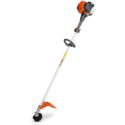 |
Husqvarna 324L Cutting Path Gas String Trimmer |
|
CHECK PRICE |
Best Value
 |
 |
Remington RM25C Curved Shaft Gas String Trimmer |
|
CHECK PRICE |
Premium Choice
 |
 |
Milwaukee 2825-21ST M18 FUEL String Trimmer |
|
CHECK PRICE |
|
|
 |
Greenworks ST80L210 String Trimmer |
|
CHECK PRICE |
|
|
 |
Makita XUX01ZM5 Brushless Cordless Couple Shaft String Trimmer |
|
CHECK PRICE |
|
|
 |
The 7 Best Commercial Weed Eater – Reviews 2024
1. Husqvarna 324L Cutting Path Gas String Trimmer – Best Overall

The Husqvarna 324L Cutting Path Gas String Trimmer is our pick for the best overall commercial weed eater. It has a 25cc, 4-cycle engine that can spin the line up to 7,000 revolutions per minute (RPM). The 18-inch trimmer head makes short work of any tall grass and weeds, and the easy to use bumper feed releases line when you tap it on the ground for ultimate control. It’s lightweight at only 5 pounds, and it features a translucent fuel tank so you always know how much fuel remains. The air purge primer bulb removes air from the system, and it’s easy to reload the line.
The Husqvarna 324L is easy to start and cut’s through the grass with ease. The only downside we experienced was that it arrived with a spark plug that had too wide a gap. Before we fixed it, it was difficult to start and ran poorly, but it worked perfectly with the gap adjusted.
- 25cc, 4-cycle engine
- 18-inch trimmer head
- Bump feed
- Translucent fuel tank
- 7,000 RPM
- 0.9-hp engine
- 1 lb
- Straight shaft
- 70-inch length
- Spark plug gap
2. Remington RM25C Curved Shaft Gas String Trimmer – Best Value

The Remington RM25C Curved Shaft Gas String Trimmer is our pick as the best commercial weed eater for the money. It has a powerful 25cc, 2-stroke engine with QuickStart technology that makes it much easier to pull the string. It has a 16-inch trimmer head to quickly cut through the tallest grass, and a curved shaft makes it easier to see where the blade is cutting. The dual-line bump feed is twice as effective as a single line and is easy to control.
What we didn’t like about the Remington RM25C was that it was heavy at 16.1 pounds, especially with a large job. The shaft is also only 39 inches long and might be too short for some people.
- 25cc, 2-stroke engine
- QuickStart technology
- Dual-line bump feed
- 16-inch trimmer head
- Curved shaft
- 1 lb
- 39-inches long
3. Milwaukee 2825-21ST M18 FUEL String Trimmer – Premium Choice
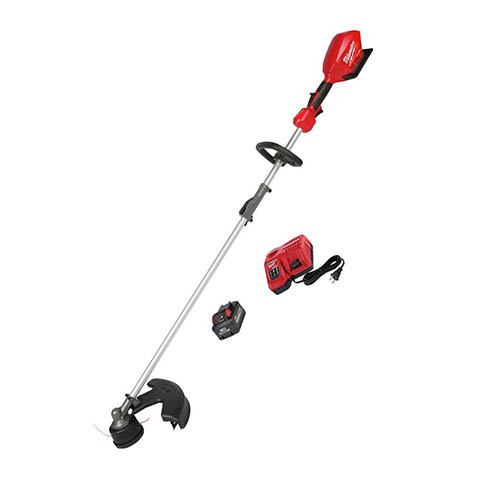
The Milwaukee 2825-21ST M18 FUEL String Trimmer is our premium choice pick. It’s a battery-powered trimmer that allows complete portability and near-silent operation. The battery and charger come with it, and it can run close to an hour on a single charge thanks to its brushless motor that uses less power and creates less heat. It has a straight 74-inch shaft that should be long enough for most people.
We enjoyed using the Milwaukee 2825-21ST and could use it early in the morning without worrying about disturbing the neighbors. However, it gets heavy quickly. There’s no weight listed on the box, but we are sure it’s more than 15 pounds.
- Battery-powered
- Includes battery and charger
- 74-inches long
- Brushless motor
- Most likely heavy
4. Greenworks ST80L210 String Trimmer
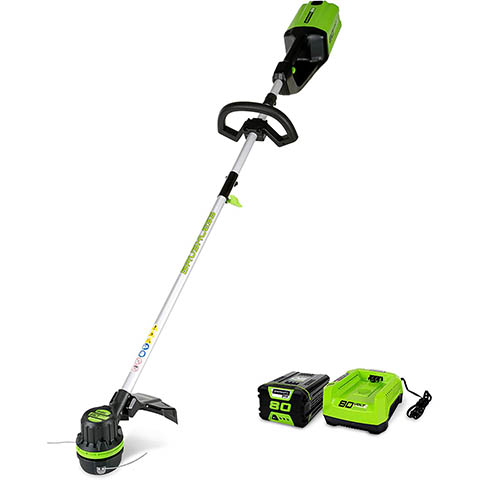
The Greenworks ST80L210 String Trimmer is another battery-powered model that features a 16-inch trimmer head. It uses a brushless motor to increase torque and battery life. One full charge usually lasts about 45 minutes. It’s not light, but it’s not heavy either at a little under 10 pounds. At 65 inches long, it should be suitable for most people.
The Greenworks ST80L210 works well, but one major flaw is the heads it uses to hold the string wear out quickly with the bump feed, and you will need to replace them often.
- 16-inch trimmer head
- Battery-powered
- Brushless motor
- 8 lb
- 65-inches long
- Head wears out quickly
5. Makita XUX01ZM5 Brushless Cordless Couple Shaft String Trimmer
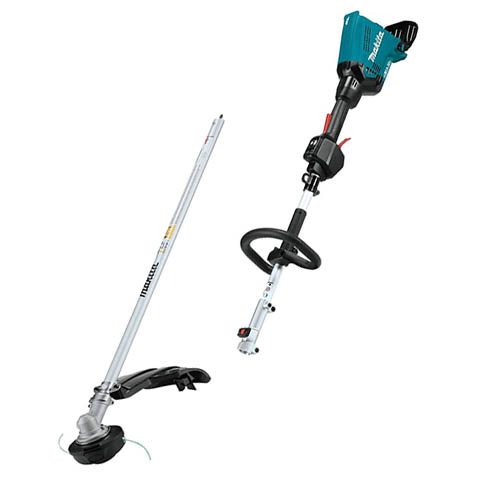
The Makita XUX01ZM5 Brushless Cordless Couple Shaft String Trimmer is a battery-powered trimmer that uses a powerful 18-volt battery. The brushless motor can produce up to 7,100 RPM, and it’s adjustable with 3 speeds so you can set a balance between power and battery life. An electronic torque control automatically shuts off the trimmer if the machine slows down or suddenly stops, and a lever style lock system makes changing heads and attachments easy.
The downside to the Makita XUX01ZM5 is that the battery and charger don’t come with your purchase, and you will need to purchase them separately. The cost can run quite high for these accessories, especially if you don’t plan on purchasing any other Makita battery-operated devices.
- Brushless motor
- 7,100 RPM
- 3 speeds
- Lever style lock system
- Electronic torque control
- Battery-powered
- 18-volt battery
- 8 lb
- Does not include the battery or charger
6. Honda HHT35SLTAT Honda Trimmers
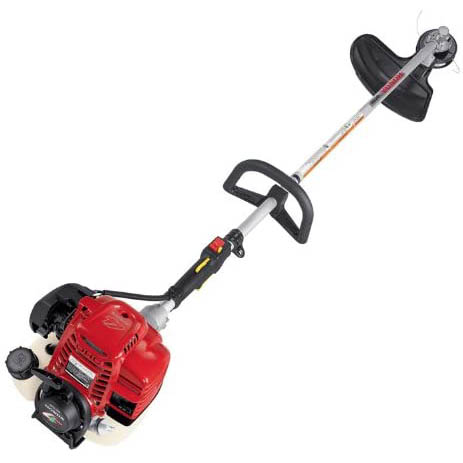
The Honda HHT35SLTAT Honda Trimmers uses a powerful 35cc, 4-stroke motor and a 17-inch trimmer head to make short work of even large yards. The straight shaft is extendable to 75 inches and should be suitable for most people.
The downside to the Honda HHT35SLTAT is that it quickly goes through gas, which is not surprising considering the engine size, but it would often run out when we were far from a refill source. The trimmer is difficult to get off the tool, and refilling it is tedious, and it’s difficult to get the head back on when you are finished. At 17 pounds, it can get quite heavy after a short time.
- 35cc, 4-stroke engine
- 17-inch trimmer head
- 75-inches long
- 17-pounds
- Difficulty with trimmer’s head
- Uses gas quickly
- Hard to refill with string
7. Craftsman CMXGTAMD30SA Straight Shaft String Trimmer

The Craftsman CMXGTAMD30SA Straight Shaft String Trimmer is the last model on our list to review for you, and this one features a large 30cc, 4-cycle engine that provides the user with a 17-inch cutting width. The shaft is straight, so it’s easier to use in some situations, especially when using attachments. It has a two-step starting mechanism where you push a priming bulb before pulling the string for easy starting. A multi-position handle helps make holding it more comfortable, and it also helps to reduce vibrations.
The downside to the Craftsman CMXGTAMD30SA is that it is quite heavy at 21.5 pounds, and it can get tiresome to use for extended work. It’s also short at just under 40 inches and may not be suitable for some users. Plus, we had a hard time getting it started. When we tried to use attachments with this model, it broke the driveshaft.
- Straight shaft
- 2-step starting
- Multi-position handle
- 30cc, 4-cycle engine
- 17-inch cutting width
- 5 pounds
- Flimsy driveshaft
- Hard to start
- 38 inches long

Buyer’s Guide – Choosing the Best Commercial Weed Eater
Here are a few things to think about before you purchase an industrial weed eater. Read on for tips on narrowing down the perfect weed eater for all your trimming needs.
Fuel
The first thing you will need to decide is whether to use battery power or gasoline. You can also use electricity, but we left those out because the power cord makes that type unusable for commercial work because it’s not portable enough.
Gasoline
Gasoline is probably the best option for most people as it supplies the most power, and as long as you have fuel to refill the tank, the power remains constant. The motor is also much more durable but will require more maintenance, especially concerning the air filter, spark plug, and carburetor. It also produces emissions that are harmful to the environment.
- Continuous power
- Durable
- Bad for the environment
- High maintenance
Battery Power
Modern battery power is very powerful and, in many cases, can replace gasoline-powered tools. Batteries are much better for the environment and much quieter as well. The downside to battery power is that it will require frequent charging, and many tools lose their strength as the charge depletes. The battery and charger rarely come with it, and they are quite expensive.
- Portable
- Powerful
- Good for the environment
- Frequent charging
- Need to purchase battery and charger separately
Engine Strength
Volts
When choosing a battery-powered model, you want to choose one that uses an 18 or 20-volt lithium-ion battery. Anything less may not have enough power, or it may lose power too quickly.
Cycles
When choosing a gasoline-powered engine, you will usually see one statistic referring to a 2 or 4-cycle engine. Four cycles are better than 2 cycles, and they accept ordinary gasoline, where 2-cycle engines require a gas and oil mix.
CC
CC means a cubic centimeter, and it talks about displacement in the fuel system. More displacement equals more power, so an engine with higher CCs will have more power. We tried to list the CCs of gasoline-powered models on our list, and we recommend going with the model with the larger value if you’re choosing between two. The one downside to a larger engine is that it will use more gas and produce more harmful greenhouse gas emissions.
Weight
You will need to carry your weed eater quite a bit when using it in a commercial setting. While you will quickly build the strength required to do so, a lighter model will be much easier to work with for an extended time. On our list, we considered everything over 10 pounds heavy, but you may be able to go a little heavier in some cases.
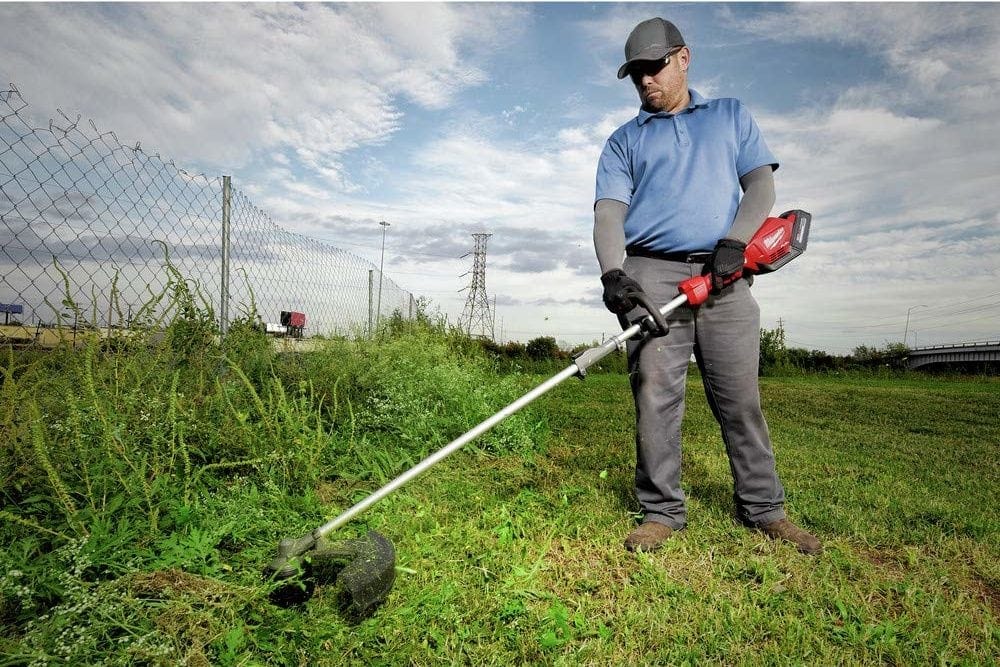
Shaft
Some shafts are straight, while others are curved. The curved type lets you see the cutting line better, so you can make more accurate cuts, while the straight shaft allows you to get into hard-to-reach areas. It’s also a bit harder to use attachments with curved shafts, and you probably see fewer of them in the field.
Cutting Width
The cutting width that the weed eater provides can make a big difference in how long it takes you to complete a project. A wider cutting will go through more string, but the time-saving advantage makes it worth it. If choosing between two similar models, we recommend the one with the bigger cutting width.
Bump Feed
There are two ways to get more line while you are working, bump feed and automatic feed. Automatic devices are complex and difficult to repair, so we left them off our list of commercial weed eaters. These models are all bump feed, which means that you gently tap it off the ground to release more when you need it. Bump feed is the original time-tested method, and it allows much more control over your line than is possible with an automatic feed.
The only downside to bump feed is that you can damage the head and guard if you are not careful and bump the machine too hard. Bumping is a very common way to damage the weed eater, so we recommend taking the time to learn proper technique before anything else.
Durability
Your weed eater can take a lot of abuse from bumping and general use while using it in a commercial setting. You will want to make sure any model you are looking at uses durable materials and not thin, flimsy plastic. Most of the models on our list performed well in durability tests, but we tried to point out any models that could improve.

String Loading
No matter what, you are going to run out of string and need to replace it. Most models require you to rewind it by hand, but some make it much more difficult than others. Some use a fancy ratchet system, while others need you to disassemble the head to add more string. We tried to list any models that used outdated systems in our reviews.
Length
We have noticed that many companies seem to be cutting costs by shortening the length of the weed eater shaft. We reviewed several models that caused us to lean over while we were working, leading to back pain if maintained for a long work session, and a few of them made it onto our list. We recommend looking for a shaft at least 60-inches long if you are taller than 5’8”. We tried to point out the models on our list that were shorter so you can avoid them, but if you aren’t that tall, you might want to give them a try.
Safety
Most people don’t consider using a weed eater to be a very dangerous job, but it can create flying particles that injure your legs and possibly face. The volume of gas motors can damage your hearing, and the exhaust and dust van get into your lungs. We recommend wearing suitable eye protection as well as ear muffs on every job. If your machine creates a lot of smoke or is working in a dusty area, you should wear a dust mask.

In Conclusion
If you are still on the fence about which commercial weed eater to purchase, we highly recommend our best overall choice. The Husqvarna 324L Cutting Path Gas String Trimmer is extremely effective, runs on plain gasoline, and features a huge 18-inch trimmer head making it one of the most powerful trimmers on this list. If you are looking for something a little smaller, the Remington RM25C Curved Shaft Gas String Trimmer is a smart choice. It’s our pick for the best value, and it features all of the same features as the top choice in a smaller, less expensive package.
We hope you have enjoyed reading our reviews, and they have helped you find your next tool. Please share this guide to the best commercial weed eaters on Facebook and Twitter if you have found it informative.
More on weed eaters:
- 5 Best Weed Eaters – Top Picks, Reviews & Guide
- 8 Best Lightweight Weed Eaters – Reviews & Buying Guide
- 6 Best Weed Eaters for Women – Reviews & Buyer’s Guide
Contents

